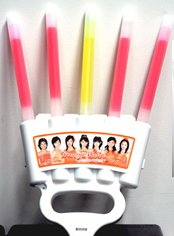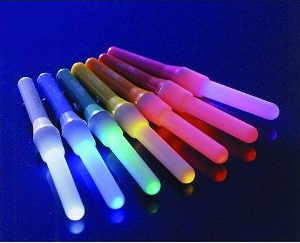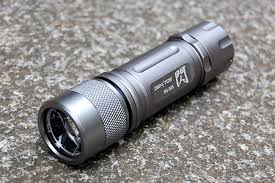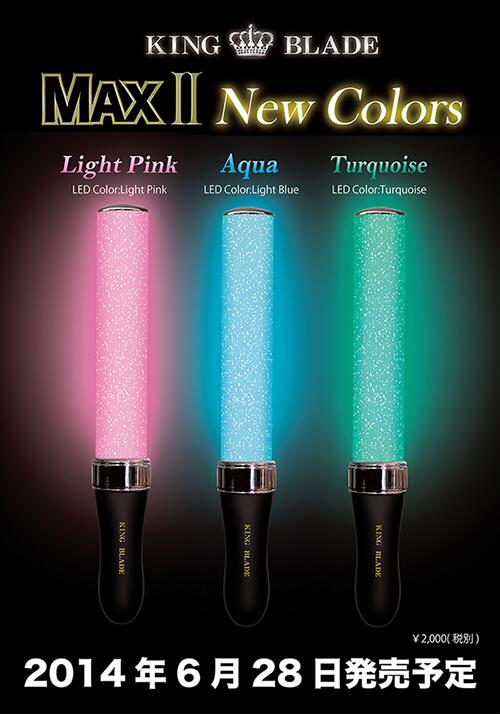When you think of idol concerts, one of the first thing that comes to mind is probably glow sticks. Would you believe it if I told you there was a time when glow sticks were not found at Hello! Project concerts? Remember the time when there were no member colors and no flashy outfits? Yes, I’m talking about 2004; we have come a long way since ten years ago. March 2005, Morning Musume Concert Tour 2005 Haru ~Dai 6 Kan Hit Mankai!~ was the first time in H!P history when image (member) colors were assigned. It was from then on that showing support for your favorite girl became as simple as wearing her color and holding the corresponding colored glow stick in your hand. As designs of official goods and merchandise evolved to being more member individualistic, the importance of member color grew in correlation. Let’s take a look at the history of concert use glow sticks and how to pick the glow stick that’s right for you.
History of glow sticks regarding Hello! Project
Cyalume or chemical glow stick was invented in the early 1960s in America. Originally intended for outdoor use such as camping and diving, it eventually found its way into recreational use. Although Morning Musume members did not have assigned member colors until 2005, it did not stop fans from using glow sticks at concerts. Early on, glow sticks were predominately used at graduation concerts, where fans all held up white glow sticks as the graduating member sang her last song as a member of the group.
Sequentially, as member colors came into play, it was only natural to use glow sticks to represent your favorite member during any concert. Up-front saw this as an opportunity to sell their own official H!P re-branded glow sticks.
Wotas eventually realized they were spending way too much on buying chemical glow sticks for every single concert and thought there must be a better way. One day, some brilliant mind decided to show up at a concert with a LED safety wand. That’s right, the same safety wand construction workers, policemen, and aircraft marshallers uses were bought into a concert hall.
Safety wands easily out powered most chemical glow sticks, allowing the user to easily get their oshimen’s attention, but not without major drawbacks. First, a typical safety wand measures 1 inch in diameter and ranges from 12 to 18 inches in length. Not only does the size makes it hard to swing around, it blocks the view of anyone behind it. Second, because it was designed to be used outdoors for long period of time, most safety wands are powered by two to three C or D size batteries, making it very heavy and difficult to swing above one’s head. Third, safety wands generally only comes in red, with other others being almost impossible to come across, making it only useful for member’s who’s color is red. Lastly, at around 2000 to 4000yen each, one would have to attend 20 to 40 concerts before a wand would pay for itself in usage. On the bright side, most safety wands have a strobe mode! Although safety wands did catch on, since it is available at most department store, it eventually were phased out by smaller products.
Sometimes you’ll hear idols comment on how beautiful the concert hall is lit up by a sea of pen light. Many of the first concert use LED glow sticks were in fact shaped liked pens, literally a pen light. Two of the most popular brands are:
These come in a variety of colors and are small and light weight, perfect for waving around during concerts. Brightness is similar to regular chemical sticks, but its small replaceable coin batteries limit usage time by half. Since these pen lights cost a little more then a chemical stick, and it is cheaper to just buy a new stick then to buy replacement batteries, it has no real advantage over it’s non-battery powered counterpart.
Meeting the demand for a brighter and longer lasting LED glow stick, the Pocket Neon was born:
Its overall length is roughly the same as chemical sticks and pen lights, but with a big handle where it houses two AAA batteries. This mean that not only can rechargeable AAA batteries be used, it has enough energy to light up a higher power LED for long periods of time.

It easily out powers all other pen lights.
The only drawback is that unlike other pen lights where the entire body lights up, only the skinny top half of the Pocket Neon can be lit.
By this time, the concert glow stick market was beginning to heat up. Yamato Industrial came out with a product that took things to the next level, the Cheer Light.
While no bigger than the largest pen light, with its single 5mm LED powered by three N size batteries, it easily defeats most of its competitor in terms of longevity while maintaining the same level of brightness. Although a Pocket Neon should outlast a Cheer Light, many still preferred the latter for it’s thicker glow tube. Right now, you might be wondering, “So what is so special about these Cheer Light?” First, let’s look at what makes them light up:
The handle is big enough just to house three 1.5Volt N size (aka 23A or LR1) batteries.
The top white glow tube houses the LED at its base and simply screws onto the handle. When the two halves make a tight enough contact, the power circuit connects and the LED lights up, no power button required.
Here’s the 5mm LED on the circuit board that’s no bigger than a US quarter. All it needs it’s a resistor to modulate power going into the LED when the two halves combine.
What makes a Cheer Light so great is it’s tolerance to modification. By around this time, when everyone shows up to concerts with similarly small glow sticks in hand and using big safety wand made no sense, the only way to stand out was to be brighter. Generally, the popular way to make a Cheer Light brighter is to increase the amount of LEDs inside the tube.
In this example, four more 5mm LEDs and resistors are added in parallel.
When regular LEDs are still not bright enough, bigger high power LEDs can be used. Flux LEDs shown here connected in series.
Left: Regular pink Cheer Light with a single 5mm LED
Right: Modified pink Cheer Light with five Flux LEDs
As you can see, the difference in power is worth all the trouble of calculating circuit resistance and soldering extra LEDs and resistors onto the tiny board. High powered modified Cheer Lights quickly became a stable amongst wotas and Yamato Industrial saw this as an opportunity to release their own version.
And so came the High Power Cheer Light. Its bigger body was able to house 3 AAA batteries powering its single high power LED. This was the perfect factory solution for anyone who wanted a brighter glow stick but have no clue on how to modify a Cheer Light.
Shown here, a High Power Cheer Light easily out performs the normal Cheer Light on the far left, while it hold its own against the 3 modified Cheer Lights on the right. Nevertheless, Cheer Lights remain popular for it’s small size and flexibility, that High Power Cheer Light never really caught on. It wasn’t until the next wota innovation that Cheer Light felt from the top spot.
Do you remember a few years back, when LED flashlights was all the rage? They were small enough to be mounted on bicycles as headlights, and versatile enough to be used when camping or in a power outage. Along the line, someone thought what if we turn a LED flashlight into a glow stick. A Cheer light pretty much just a colored LED flashlight with a white tube on top. What if we just add a tube on top of a regular LED flashlight, wouldn’t that make a powerful glow stick? In theory, the concept is simple, but there are two main problems. One, was finding a LED flashlight small and light yet bright enough to out shine modified Cheer Lights. Two, a proper size tube was needed to diffuse the light coming out of the flashlight. As luck would have it, a company call Turn On makes LED glow sticks using a clear tube and color films system to create an assortment of colors for the casual concert goer market.
Turn On was popular for its light weight and low price. These are literally oversize pen lights that weight next to nothing. They’re called Turn On as they function exactly like Cheer Lights, where they’re simple turned to come on.
Using a translucent film, it is able to diffuse light from the single low power white LED into any color of the spectrum. Changing color is as easy as inserting another Turn On color film or using films from any arts and craft store.
With the tube candidate selected, it wasn’t long until a matching flashlight was discovered.
Meet the GENTOS SENN SG-305, a three AAA battery powered, 100 lumen LEXEON Rebel 90 LED flashlight, capable of 10 hours sustained use, and no bigger than the handle of a High Power Cheer Light. Both Turn On and SG-305 share a similar diameter, a match made in heaven. Problem now was how to connect them together.
Cut the handle off the Turn On, keeping the threaded end, to create an adapter for the GENTOS.
One can also use a bottle cap if it is too difficult to saw through the thick Turn On handle. Be sure the bottle cap has the same thread spacing as the Turn On tube or they won’t twist together.
Glue the adapter to the lens cap of the SG-305.
Wrap with electrical tape for extra strength.
And assemble together. Congratulations, you have just made your own “Sen Blade”.
Compared to a High Power Cheer Light, the Sen Blade’s light is brighter and more uniform.
*To the delight of attention seeking wotas, the SG-305 was superseded in 2011 by the SG-325, capable of producing 50 extra lumen of light over its predecessor.
Taking the basic idea of Sen Blade, it was not long until many variation to appeared, especially from high school kids who could not afford the 3000yen (~$30) in parts to create a proper Sen Blade. Alternative LED flashlights from 100yen stores were used resulting in mostly poor results. Regardless, it was the pride of holding one’s own creation that drove many to make their own version of Sen Blade from scratch.
The Sen Blade phenomenon caused such a big stir in the market that a third party company created its own mass produced quick release Sen Blade adapter.
Originally a creation of anime/seiyuu fans, by 2012, every idol concert was filled with a sea of Sen Blade. Unfortunately, there is a sad ending to this story. The fact that not all Sen Blades are created equal means that some were properly put together following the original idea, while many others were half witted hack jobs which proof to be quite hazardous especially in a crowded setting. Adapters not properly glued together allowed tubes to fly off, injuring oneself or others. Poor sealing jobs and ill fitting color films fails to contain light inside the glow stick, blinding the very idol they are trying to cheer for. It didn’t take very long until Sen Blades were banned from most concerts in Japan. Although some are still being used at various unrestricted events, the majority have moved on to the next big thing.
As idol groups increases in size, with each member having her own color, the need for many different color glow sticks each concert grew. Luckily for us, technology is advancing at a blistering pace. With the help of RGB LEDs, it is possible to have an assortment of color in a single glow stick. Play Avenue was one for the first to introduce a multicolor glow stick, the Colorful Beam.
Changing color is as simple as turning the number dial. The power button doubled as a strobe controller. With 12 colors and 4 gradations, it boast an impressive 40 patterns of light. Sadly, this glow stick also has many unforeseen faults, preventing it from taking over the market. Having a thick white tube means translucent property was sub-par, leading to weak light output barely suppresses a small pen light. Light also stayed at the base of the tube due to a poor diffusion design. But the main problem it was deemed a failure is its over length. When Sen Blade ruined the scene, event organizers began putting restrictions on what glow sticks can be used at concerts. One common rule is that a glow stick can be no longer than 25cm in total length. A Colorful Beam is 27cm. Probably it was designed and put into production before rule changes took place, so Play Avenue had no time to fix this problem. Shortening or replacing the tube was also out of the question because the used of modified glow sticks was another major rule most organizers put in place.
A few companies took the lessons learned from Colorful Beam for their own RGB glow stick designs, but it wasn’t until August 2012, when the definitive answer arrived.
King of blade light, King Blade X10.
In essence a mass produced Sen Blade, King Blade took the market by storm.
Utilizing a 1.5watt RGB LED, the King Blade X10 is capable of two to ten hours of sustained use depending on color. Its one bottom mounted button allows users to cycle through its arsenal of 12 bright colors. The name itself is most likely derived from Sen Blade, since it shares the same basic design. However, since it is manufactured by RUIFAN JAPAN, and not Turn On, the tubes are not compatible across the two brands, but RUIFAN JAPAN does offer their own tubes as separate accessories. Its 25cm length and controlled brightness ensured it to conform to most concert regulations. Soon, Sen Blade and other glow sticks users all switched over to King Blade.
In July 2013, the King Blade X10 II was released. New features include an extra button reverse color cycling, last color recall mode, strobe mode, color order memory mode, as well as the addition of 3 new colors. Price remained at 3000yen (~$30).
March 2014, RUIFAN JAPAN announced at Anime Japan 2014 that King Blade X10 III is slated for 2014 summer release. No further details were given.
Those of you with sharp eyes have probably already figured out that RUIFAN JAPAN is also responsible for manufacturing official glow sticks for various idols, including Morning Musume, Berryz Koubou, Up Up Girls (Kari) and more. These glow sticks are essentially King Blade X10 with custom designs and colors corresponding to each group.
Which glow stick should I buy?
For most people at this very moment, King Blade X10 II.
- It meets most concert rules
- Light weight
- Good on batteries
- Can switch between 15 colors (covers all Hello! Project member colors currently in use)
- Various modes and settings
Those who wants to pay 500yen (~$5) more for the Morning Musume ’14 King Blade for the novelty can do so at the cost of losing a few colors such as sky blue (Nakky and Kananan fans beware). On the other hand, the two Morning Musume King Blades offers colors specific to Morning Musume members not found on regular King Blade, namely Eripon’s Yellow-Green, Haruna’s Honey, and Ma-chan’s Emerald Green. Haruna’s Honey color is a lighter shade than a typical yellow, but using any yellow glow sticks is sufficient since she’s the only current Morning Musume member using yellow. Eripon, Zukki and Ma-chan are all green member colors just in different hue. Zukki’s bright green is featured as a standard color on most RGB glow sticks. Eripon’s and Ma-chan’s color are not normally found in glow stick form, so I recommend fans of these two members to purchase a Morning Musume King Blade. Otherwise, if you’re not too hung up on details, any light green should work. (I’m pretty sure it’s quite a task for the members to tell apart the slight difference in various hue of green from a distance anyway.)
Updated on June 16, 2014: The Morning Musume ’14 has been discontinued, however, RUIFAN JAPAN is releasing King Blade MAX II in Light Pink (Sayumi), Aqua (Reina), Turquoise (Ma-chan) on June 28th. They are taking pre-orders now.
Alternatively, there are RGB glow sticks by other makers with different colors and functions which might suit your needs better. Remember to choose one not too long in length and not too bright in color. If possible, test them out at department stores with demo displays to get a sense of their performance.
To those who only needs single color glow sticks, RUIFAN JAPAN also carries a cheaper and brighter single color variant of the King Blade X10 II, the King Blade Max II, which I also recommends.
Where to buy
I noticed quite a few asking where to purchase these glow sticks outside of Japan. RUIFAN JAPAN has an online shop you can purchase from but they do not ship overseas. Lumica also has an online shop. And Turn-on has an online shop too. WakWakLive and UltraOrange are glow stick web stores, they carry many of the popular brands. Please use a deputy service, such as FromJapan or Tenso/Buyee for delivering items from Japan to you. Other brands can be found on Amazon Japan, Rakuten, and other major online retailers.
One last advice. If you are on a tight budget, or forget to bring your glow sticks to a show, do NOT purchase an official Hello! Project chemical glow stick at the venue for 300yen (~$3) each. Go instead to the nearest 100yen or department store to buy regular chemical glow sticks at 100yen (~$1) each. The foam handle of the H!P stick is not worth paying an extra 200yen (~$2) for.
I hope you now have a better understanding of glow sticking with regard to Hello! Project. Please feel free to comment below if you have any questions or comments.
Further reading
Ultimate resource and review website for anything glow stick related
http://monta.moe.in/wp/
(Japanese only)





























Awesome writeup turbos. I’m planing on getting a UUG King Blade.
LikeLike
Good choice, I’m sure you’ll like it.
LikeLike
Thx turbo. I checked out the MM version but its not as bright so i’ll buy the orginal king blade.
LikeLike
Be sure to get the II, the older models are the same brightness as the MM one.
LikeLike
Is this a modified King Blade with 7 LEDs?
LikeLike
Looks like rhinestones people uses to decorate their phones with.
LikeLike
Cool info. I was wondering about this the other day as my king blade didnt seem to have Maachan’s color which i ll be needing next month. I suppose i should get the newer king blade? ^^;
LikeLike
Ma-chan’s and Eripon’s colors are not on any regular versions of King Blade. Only the Morning Musume Chance King Blade and the Morning Musume ’14 King Blade have these two specific colors. However, the King Blade X10 II has a Light Green (9th color, after the yellow) similar to Ma-chan’s Emerald Green, but nothing close to Eripon’s Yellow-Green.
Get the MM ’14 blade if you can, otherwise go for a X10 II.
LikeLike
Is the MM ’14 an X10 II? Since it has the reverse button and all.
LikeLike
I don’t have one in my hands yet, so I’m not certain if the MM ’14 blade contains all the same upgrade as the X10 II aside from the added reverse button. The only thing certain from Eripon and Ayumi’s goods showcase video is that it only has 10 specific member colors instead of 15 in X10 II. https://www.youtube.com/watch?v=Ft_RJhiTzMA
LikeLike
From the packaging of the MM ’14 blade, other than explanation of the color reverse button, it is identical to the first MM blade. http://twitpic.com/dybtvz A fan report indicates the new version shows cleaner colors thanks to a more clear tube, but not noticeably brighter. http://ameblo.jp/airikappa/entry-11798354488.html It is safe to say that the MM ’14 blade’s only difference from the old version is the reverse button and that it is still based on the X10, not X10 II.
LikeLike
aha! – I lost my Pocket Neon years ago – any idea where I can buy one please? (had a blue one) Thanks!
LikeLike
Try Don Quixote (Donki Hote) or Tokyu Hands.
LikeLike
Helpful article. Last time I tried to look up glow stick info the best I found was one from a few years back that concluded ones people made themselves were best. That was pre-King Blade, though. I ordered an X 10 II after reading this and it recently arrived. Nice little device, and seems plenty bright to me.
LikeLike
Glad it was useful in helping you make a purchase!
LikeLike
Just wanted to share this video. A nice example of King Blade as a dance prop.
LikeLike
Im thinking of getting the King Blade X10 II from amazon beacuse I am going to the morning musume 14 concert in new york!!! Im hoping the one from amazon is legit
LikeLike
Probably legit, but it’s $100 when the original price is about $35.
LikeLike
On amazon is like $31+$5 shipping which it’s not bad. I was also looking at some YouTube videos of it and I found out that you can program the colors you want to use, which is pretty cool.
LikeLike
Amazing, well thought out and put together guide. Thank you so much!!
LikeLike
Hope it is helpful to you! Thanks for checking it out!
LikeLike
Oh so it was a good idea to get the Evolution King Blade (since I’m an Eripon fan)
Anyways, any of these Momusu blades are showing up for good prices now on yahoo auctions (probably because these are now outdated, Sayu has left and 12ki will join). Anyways, I don’t mind it being outdated. I likely won’t use any other color than light green… heh
LikeLike
Not really outdated until they release a new one with 12th gen colors added. Chance and Evolution blades are nice to have, for the novelty, even if you’re not an Eripon fan, bonus if you are.
LikeLike